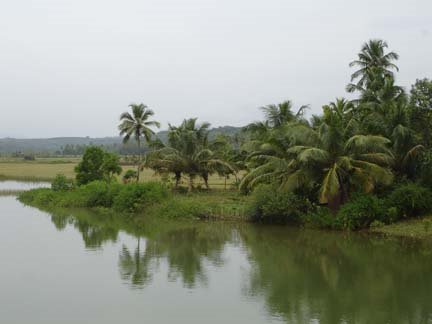“ Paani da rang vekh ke,
ankhiyan cho hanju rod de”.
-On seeing
the color of the water tears rolled down from (my eyes).
The cited Punjabi
lyrical lines penned by Anshuman Khurana’s and popularized in the Hindi film Vicky Donor has haunted
me many times especially for the presence of preposition ‘da’. The common preposition
da (pronounced as 'the' in English) in Punjabi as well as in Tulu Language
represents the English preposition of
! Like ‘pāni da’ in Punjabi ‘neer da’ in Tulu means relating to water.
Punjabi and Tulu
Punjabi is a
north Indian language belonging to the family of Indo-Aryan languages. Tulu is a
Dravidian language. Even though the two languages are entirely different in
structure and content, this particular preposition is common to the two
languages. Many may like to consider this common preposition in Punjabi and
Tulu as a mere coincidence.
Da, di, de
There are
other prepositions related to da in Punjabi and Tulu. The equivalents in Hindi
are ko, ki and ke. The feminine
form di is used in Hindi as a suffix for
Goddesses like Mātā-di. The feminine
form di (ki in Hindi) or ti has also been vogue in Tulu in forms reverential
feminine forms such as Ullaldi/ Ullalti, Shedti,
Konkandi, Marakaldi/ Marakalti, Sapaldi/Sapalti, Baideti/Baidedi, Baikaadi/Baikaadti', Maankaldi/ Mangaldi etc.
It is also (especially the -de feminine form) there
in Tulu usages in respect of feminine genders as in Dāda de ? or Dāni de? or Anda de! ..etc.
In Tamil Da (masculine) and Di (feminine) suffix forms do exist; However these are pronounced as Da and Di (D as in Dog). In Kannada feminine suffix ti (instead of di) has survived, even though other forms (da, de) have apparently vanished during the course of evolution.
In Tamil Da (masculine) and Di (feminine) suffix forms do exist; However these are pronounced as Da and Di (D as in Dog). In Kannada feminine suffix ti (instead of di) has survived, even though other forms (da, de) have apparently vanished during the course of evolution.
Migration route
One of the
possibilities is that a component of migrating speakers of Tulu language who
had lived in the northwestern Indian subcontinent during the ancient history picked
up and absorbed this preposition. The migration of the people during the
history from the North-western Indian subcontinent to the Karavali has brought
the preposition da along with them.
It has been
pointed out in earlier posts herein that the Tulu word pirak (=ancient) signifies the place name Pirak, which is a part of
Pakistan now.
Mediterranean roots?
The
preposition da can be found survivng
in a number of Mediterranean and European languages. The word da has varied meanings in some of the European
languages such as : from or of (in Italian and Dalmatian), yes (in Russian), to
(in Breton), surely, then, when, as etc (in Danish) and so on. Of these it can
be seen that the meaning of da is
quite close to that of Punjabi and Tulu in the case of Mediterranean
languages like Italian and Dalmatian.
In our older
posts, Kaudur Narayana Shetty has contributed an essay outlining the similarities
between the Italian and Tulu languages.
Â


